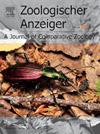Antennal sensory array in the Argentine ant, Linepithema humile, and two carpenter ants, Camponotus mus and Camponotus aethiops
IF 1.5
3区 生物学
Q2 ZOOLOGY
引用次数: 0
Abstract
Ants play a crucial role in both natural settings, impacting ecosystem functions, and in human-altered environments, where they can potentially cause harm. The Argentine ant, Linepithema humile, is recognized globally as an important invasive species, known for its ability to colonize diverse habitats and causing significant ecological and economic damage. In contrast, species of the Camponotus genus, while sharing similar food habits, typically have more restricted ranges and are also highly adapted to human-modified environments. This study serves as a foundational investigation into the antennal morphology of L. humile and two Camponotus species—one native and one from the invasive range of L. humile. We employed a systematic sampling method to analyse the distribution and relative abundance of chaetic, basiconic, and trichoidea sensilla along the last antennomere. Our results indicate that Camponotus and .L. humile have similar proportions of the sensilla analysed, with chaetic and basiconic sensilla increasing towards the tip, while trichoidea sensilla tended to decrease. Notably, both native species of Argentina, L. humile and Camponotus mus, exhibited significantly higher abundances of chaetic and trichoidea curvata sensilla compared to Camponotus aethiops from France. This study establishes a framework for future research aimed at exploring the chemosensory responses associated with these sensilla, paving the way for deeper insights into how these ants interact with their environment.
阿根廷蚁(Linepithema humile)和两种木蚁(Camponotus mus和aethiops)的触角感觉阵列
蚂蚁在自然环境中扮演着至关重要的角色,影响着生态系统功能,在人类改变的环境中,它们可能会造成伤害。阿根廷蚂蚁(Linepithema humile)是全球公认的重要入侵物种,以其在多种栖息地定居的能力而闻名,并造成重大的生态和经济破坏。相比之下,虽然有相似的饮食习惯,但通常有更有限的活动范围,也高度适应人类改造的环境。本研究对黄草和两种黄草的触角形态进行了基础研究,其中一种是本土的,另一种是入侵的。我们采用系统取样的方法,分析了最后一个触角节上的毛状、基状和毛状感受器的分布和相对丰度。我们的研究结果表明,冠状虫和l。Humile所分析的感受器比例相似,向尖端增加的是chaetic和basiconic感受器,而向尖端减少的是毛状感受器。值得注意的是,阿根廷本土种L. humile和Camponotus mus的chaetic和trichoidea curvata sensilla的丰度都明显高于法国的Camponotus aethiops。这项研究为未来的研究建立了一个框架,旨在探索与这些感受器相关的化学感觉反应,为深入了解这些蚂蚁如何与环境相互作用铺平了道路。
本文章由计算机程序翻译,如有差异,请以英文原文为准。
求助全文
约1分钟内获得全文
求助全文
来源期刊

Zoologischer Anzeiger
生物-动物学
CiteScore
2.80
自引率
7.10%
发文量
75
审稿时长
>12 weeks
期刊介绍:
Zoologischer Anzeiger - A Journal of Comparative Zoology is devoted to comparative zoology with a special emphasis on morphology, systematics, biogeography, and evolutionary biology targeting all metazoans, both modern and extinct. We also consider taxonomic submissions addressing a broader systematic and/or evolutionary context. The overall aim of the journal is to contribute to our understanding of the organismic world from an evolutionary perspective.
The journal Zoologischer Anzeiger invites suggestions for special issues. Interested parties may contact one of the editors.
 求助内容:
求助内容: 应助结果提醒方式:
应助结果提醒方式:


